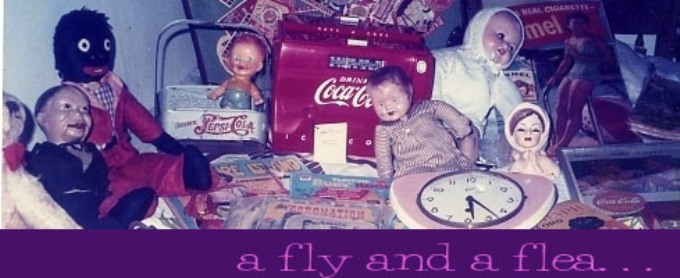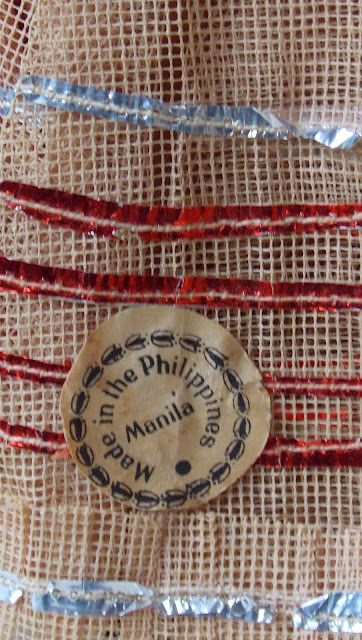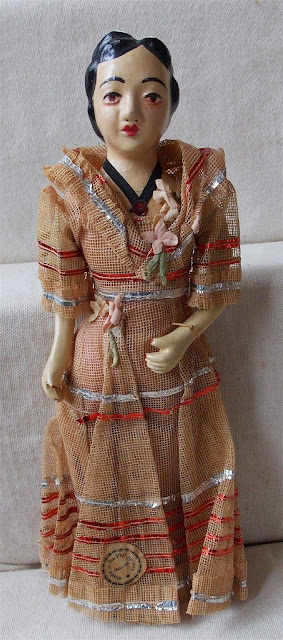In the 1930s--our peacetime era--tourism in the Philippines boomed. many bazaars and curio shops mushroomed in the Malate area, selling Philippine-made souvenirs to domestic and international tourist. Capiz shells, abaca products, woodcarvings, buri hats, banig (mats) and woven jusi and pina fiber were top sellers. For kids,there were a few options--yoyos and pull toys (calesas) for the boys, and for the girls-- Philippine-made dolls of composition with cloth bodies attired in baro't saya, like this example, in very good condition.
These were most likely outsourced from contractors who made these at home, products of Philippine cottage industry. They are very fragile, as the composition tend to crack over time, but this charming doll has retained its color, its dress and even its label. She is dressed in a stiffened abaca skirt and top, with a panuelo to complete her 'dalagang bukid' look.
These vintage Philippine dolls occasionally are seen on ebay--like this small 11 inch creation. Thank heavens, they are not that expensive and demand is not too high, so they are very much affordable. Much rarer are bigger dolls of over a foot in length, made in the same fashion, but with heads of painted clay and more elaborate costumes. Dolls using raw Philippine materials are not just nostalgic souvenirs of childhood but wonderful examples of Philippine folk art.
Wednesday, June 10, 2015
335. Among My Souvenirs: VINTAGE FILIPINA DOLL
Labels:
1930s,
composition,
doll,
ebay,
Filipiniana,
holiday collectibles,
toy
Subscribe to:
Post Comments (Atom)










So beautiful, sir Alex! :D
ReplyDeleteClarifications:
ReplyDeleteThe doll's attire was properly called traje de mestiza, & was used for formal occasions.
It is only called "baro't saya" if the material is made out of lesser-quality textiles, the composition is just blouse-&-skirt, and is used as everyday wear (usually seen in photos of the provinces).
The mesh material of the entire dress is actually called cañamazo (misspelled as either kanyamaso or canyamaso and is also mistakenly used as a term for the sleeves), and was used in pre-War traje de mestizas for the sleeves (hence the misunderstanding), due to the necessary translucency.
A pañuelo was a pre-War ABSOLUTE NECESSAIRE in the traje de mestiza, a must-wear for formal occassions, as not only did it covered the upper body however small it was, it also served as a decorative piece (as seen by the pinned flower corsages) in the otherwise bare camisa.
The fashion is in the late 1930's to the entire 1940's, where designers actually became quite creative in the appearance of the traje de mestiza, but stil stuck close to tradition.
However fashion has dictated that the saya de cola & the sobrefalda (tapis) be discarded.